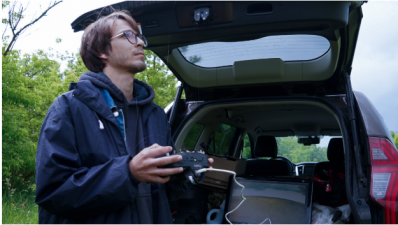KYIV OBLAST— In a forest in the Kyiv region, 35-year-old engineer Andriy Tchornim takes shelter under the trunk of a navy blue 4x4. Eyes locked on the screen of his joystick, he pays no attention to the torrential rain lashing his face in heavy gusts, nor to the barely visible thread that coils around him.
Andriy, an engineer at the mil-tech company Technohawk, is field-testing the Shtorm, the company’s new fiber-optic drone, for the first time. Unlike conventional UAVs, this new generation is tethered to the operator by a thin fiber optic cable, allowing secure, high-bandwidth, and interference-free communication—without relying on GPS or radio signals.
“This cable can extend up to 10–20 kilometers,” Andriy explains, “and it keeps us connected no matter what.”
On the Ukrainian battlefield, this technology is proving revolutionary. Since 2022, both sides have deployed thousands of drones, from cheap first-person-view (FPV) kamikaze drones used for frontline strikes to more advanced loitering munitions like Russia’s Lancet and Ukraine’s Vampire. These systems rely heavily on radio or satellite links—channels increasingly targeted by powerful electronic warfare systems.
But fiber-optic drones like the Shtorm bypass those vulnerabilities entirely. Immune to jamming, they allow for precise artillery correction and real-time reconnaissance even in the most contested electromagnetic environments—where traditional drones often fail.
"Having that connection makes the drone undetectable—and above all, completely invulnerable to any form of electronic warfare," adds Volodymyr Makhitko, Technohawk’s chief engineer."As a result, we can strike enemy logistics with precision, without fear of being neutralized by the jamming systems currently used on the battlefield."
To compensate for its disadvantage in numbers compared with Russia, Ukraine has become a pioneer in the drone industry. When it comes to these new fiber-optic drones, however, Ukraine is playing catchup.
Russian forces used fiber-optic drones on a large scale in its counteroffensive to reclaim Kursk, and several analysts say the technology has contributed to their recent success against Ukraine on that front, where it has effectively reclaimed all the land Ukraine forces seized during their August 2024 incursion.
Since then, the Russian drone units previously deployed in Kursk have been reassigned to the Pokrovsk front in eastern Ukraine, which now accounts for around 70 percent of all Russian assaults—combining drones, infantry, and mechanized forces. The intensification of pressure along this axis, especially through the increased use of drones and fiber-optic drones, has raised alarm in Ukraine, as these systems are now systematically targeting and disrupting key logistical lines, threatening to cut off supply routes between major cities in the Donbas and strain already overstretched defensive networks.
Technological lag and initial responses.
As Ukraine tries to close the technology gap with Russia on fiber-optic drones, units on the ground are improvising.
In Pokrovsk, Capt. Ihor Matviyishyn gives a blunt assessment: For now, he tells me, no centralized production of fiber-optic drones has been implemented by the authorities in Kyiv. The only fiber-optic drones are built by the units themselves, and only certain formations, like Azov, Magyar, or Achilles, have them.
In his workshop on the outskirts of Kyiv, Volodymyr expresses cautious optimism. As 3D printers hum behind him, cranking out drone components, he tells me that it would take only a few months for Ukraine to catch up. From a technical standpoint, the challenge is not insurmountable.
These drones aren’t a technological breakthrough,” says Viktor Zubenko, CEO of Technohawk. “The real challenge,” Volodymyr adds while making coffee in the office, “is scaling up.”
Nevertheless, Viktor points out that Ukrainian drones are generally of higher quality and hit their targets 80 percent of the time. The Russians, on the other hand, only hit one in four.
Ukraine already has a well-established FPV ecosystem. But the industrialization of fiber-optic drones still depends on access to the cables necessary for their operation—components still mostly produced in China. For now, fiber-optic spools are available on AliExpress, but the dependence on Chinese parts is becoming increasingly problematic. China is showing more and more support for Moscow: In May, it ended drone exports to Ukraine and its Western allies but continues to supply Russia.
To respond to this constraint, Ukraine’s Autonomous Systems Forces presented a new device at the end of February: the Silkworm, a locally designed modular fiber-optic spool. It can equip both FPV drones and unmanned ground vehicles, which also face communication problems on the battlefield.
The challenge now is to structure this still-nascent production, explains Viktor, but he notes that the Ukrainians are using fewer and fewer Chinese spools. In a war of adaptation and innovation, Ukraine must constantly readjust.
Technical limitations and combat fragility.
While this technology has allowed Russia to regain the upper hand in the drone war, the fiber-optic drone is not without its drawbacks. The men I talked to identified several.
First, the large canisters of fiber-optic cable that make the drones invisible to electronic surveillance make them easily spotted from the battlefield. Anyone with a good shotgun can shoot them down easily, explains Andriy. And the bundle of fiber-optic cables connecting the drones to their operators makes soldiers easier to locate. Once detected, they become targets for counter-battery fire, forcing units to relocate frequently and reducing their effectiveness in the field.
Next, because the canister can weigh up to 5 kilograms, the explosive payload must be reduced, limiting a drone’s impact. It’s also important, Viktor insists, that a fiber-optic drone is more difficult to maneuver than a small FPV drone, insists.
Moreover, Volodymyr adds, this type of drone is poorly suited to the wooded environments of Donbas, Kharkiv, or Sumy. In the underbrush, the cable easily gets tangled in branches. With the wrong angle, the fiber snaps like straw. A single car—or even an animal—crossing its path is enough to break the connection.
Nevertheless, despite its limitations, Capt. Ihor is categorical: The fiber-optic drone will revolutionize the battlefield.
These drones will never replace the entire arsenal, but there’s little doubt they will become a decisive weapon. And the outcome of the war will depend, among other things, on our ability to develop our own industry while learning how to defend against them.






Please note that we at The Dispatch hold ourselves, our work, and our commenters to a higher standard than other places on the internet. We welcome comments that foster genuine debate or discussion—including comments critical of us or our work—but responses that include ad hominem attacks on fellow Dispatch members or are intended to stoke fear and anger may be moderated.
With your membership, you only have the ability to comment on The Morning Dispatch articles. Consider upgrading to join the conversation everywhere.